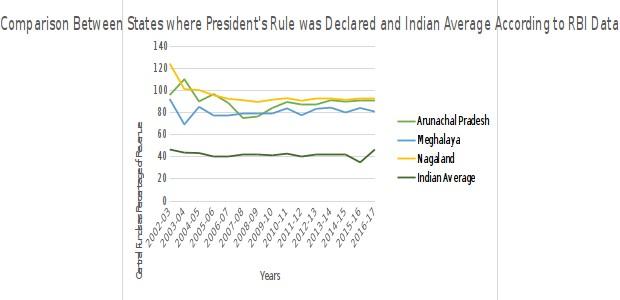Are Political Alignments in Northeast Related to Funds From the Union Government?

Image Courtesy: NELive.in
The 2015 political crisis in Arunachal Pradesh brought to fore the question whether political alignments in the Northeast shift towards the ruling party at the Centre. The reasoning is that since these eight states together send a total of 39 MPs, of which 25 are to the Lok Sabha and 14 to the Rajya Sabha, they have a limited voice in Parliament. Therefore, by aligning with the party in power at the Union level, they can continue receiving funds and assistance without any discrimination.
To check this out, Newsclick analysed data on central fund transfers to states published by the Reserve Bank of India in its annual publication ‘State Finances: A Study of Budgets’ of 2017. What was computed was this: what share of a state’s total revenue comes from the central govt.? Note that ‘gross transfers’ from the centre to states includes in the main, each states’ share of central taxes (as mandated by Finance Commissions), funds meant for ‘central’ and ‘centrally-sponsored’ schemes, and loans and grants.

As the above graph (based on RBI data) makes it clear, since 2002, Gross Transfers of funds from the Union Government to the 8 states of the Northeast, make up a disproportionately high portion of the states’ revenue, mostly in the 80 to 100 percent range. This clearly displays the dependence of the 8 states on funding from the Union Government. Part of it is explainable by the fact that all these states are economically backward, and they are border states with sensitive issues of ethnic strife and insurgencies. But this does not explain why, even so many years after the formation of these states, there has been insignificant economic development which would enable more local revenue and less dependence on central funds.
The other important question that arises is this: how do political entities in these states behave vis a vis the central govt.? One glimpse can be had from studying how much time period in each of these states has been spent under pro-central govt. party rule and how much under opposition party rule.

This table shows that both Sikkim and Tripura never had President’s Rule imposed. However, Sikkim has never been ruled by a party opposed to the party forming the Union Government. In fact the Sikkim Democratic Front (SDF), Sikkim’s dominant party, has successfully aligned with whatever party came to power at the centre even though within the state the SDF may be at loggerheads with the same party on a variety of issues. The case of Tripura is the reverse: it has continuously been ruled by the Left Front which has always been opposed to the party at the centre, except supporting the UPA 1 for an initial period (2004-2008) but that too conditionally. Notably, Tripura has several times protested at cuts in central funding of some schemes like the rural job guarantee scheme (MGNREGS). Tripura chief minister even sat on an unprecedented dharna in Delhi demanding restoration of funds in 2014.

As can be seen in the graph above, Tripura has managed to largely preserve its share of central funds despite a dip in the first NDA term. In fact, it receives a higher percentage of its revenue than Sikkim which has never had opposition rule. This is probably due to the disturbed conditions in Tripura till 2008, and more backwardness than Sikkim.
Next, when one compares the states where President’s Rule has been imposed, one can see that Nagaland had the longest time under President’s Rule, and has had the highest contribution to its revenue from the Union Government. Ironically Nagaland has also had the second longest time under opposition rule. Comparing Nagaland, Arunachal Pradesh and Meghalaya, Arunachal Pradesh had the second highest contribution from the Union Government and had had the least time under President’s Rule of the three. Arunachal Pradesh is also the state to have the second least time under opposition rule.

Regarding elected members switching parties after being elected, Arunachal Pradesh is infamous since the political crisis which began in 2015 saw the elected members switch from the Congress to the People’s Party of Arunachal (PPA), an NDA ally, then after the Supreme Court order switch back to the INC, then back to the PPA, and then finally to the BJP, leaving the former Chief Minister, Nabam Tuki as the sole INC member in the Legislative Assembly. This is irrespective if the NDA or the UPA forms the Union Government.
Therefore, to say that the political alignments within the Northeast reflect those of the Union Government is not correct in many cases although – as examples of Sikkim and Arunachal pradesh shoe – it does work like that in some cases. Furthermore, the proportion of Gross Transfers in the state’s total revenue does not reflect that such alignments are motivated by the ‘fear of reduced funds’.
The unanswered question here is where this largesse from the Union Government has gone because evidently, the 8 states continue to be backward and officially defined as ‘Special Category’, needing special attention.
In all probability, it is the elite from these states that have cornered the central largesse. It is well known that several MLAs from many of these states own properties in various cities across India and even in the NCR. Whether these properties were bought before or after getting elected is not known. If it is true that the Gross Transfers from the Union Government are for the most part ending up in the pockets of elected representatives or their patronage networks in some of these states, then it would not be too far fetched to conclude that the political alignments and realignments are merely to ensure that no questions will be asked about where the money has gone.
Get the latest reports & analysis with people's perspective on Protests, movements & deep analytical videos, discussions of the current affairs in your Telegram app. Subscribe to NewsClick's Telegram channel & get Real-Time updates on stories, as they get published on our website.
























